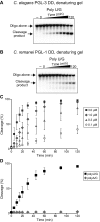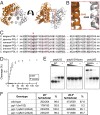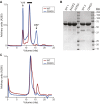PGL germ granule assembly protein is a base-specific, single-stranded RNase
- PMID: 26787882
- PMCID: PMC4747772
- DOI: 10.1073/pnas.1524400113
PGL germ granule assembly protein is a base-specific, single-stranded RNase
Abstract
Cellular RNA-protein (RNP) granules are ubiquitous and have fundamental roles in biology and RNA metabolism, but the molecular basis of their structure, assembly, and function is poorly understood. Using nematode "P-granules" as a paradigm, we focus on the PGL granule scaffold protein to gain molecular insights into RNP granule structure and assembly. We first identify a PGL dimerization domain (DD) and determine its crystal structure. PGL-1 DD has a novel 13 α-helix fold that creates a positively charged channel as a homodimer. We investigate its capacity to bind RNA and discover unexpectedly that PGL-1 DD is a guanosine-specific, single-stranded endonuclease. Discovery of the PGL homodimer, together with previous results, suggests a model in which the PGL DD dimer forms a fundamental building block for P-granule assembly. Discovery of the PGL RNase activity expands the role of RNP granule assembly proteins to include enzymatic activity in addition to their job as structural scaffolds.
Keywords: P-granules; PGL-1; PGL-3; RNA endonuclease; germ-cell development.
Conflict of interest statement
The authors declare no conflict of interest.
Figures









References
-
- Anderson P, Kedersha N. RNA granules: Post-transcriptional and epigenetic modulators of gene expression. Nat Rev Mol Cell Biol. 2009;10(6):430–436. - PubMed
-
- Brangwynne CP, et al. Germline P granules are liquid droplets that localize by controlled dissolution/condensation. Science. 2009;324(5935):1729–1732. - PubMed
Publication types
MeSH terms
Substances
Associated data
- Actions
- Actions
- Actions
Grants and funding
- GM094622/GM/NIGMS NIH HHS/United States
- F32HD071692/HD/NICHD NIH HHS/United States
- U01 GM098248/GM/NIGMS NIH HHS/United States
- GM098248/GM/NIGMS NIH HHS/United States
- K99HD081208/HD/NICHD NIH HHS/United States
- GM094584/GM/NIGMS NIH HHS/United States
- U01 GM094622/GM/NIGMS NIH HHS/United States
- ACB-12002/PHS HHS/United States
- AGM-12006/PHS HHS/United States
- GM50942/GM/NIGMS NIH HHS/United States
- R01 GM050942/GM/NIGMS NIH HHS/United States
- Howard Hughes Medical Institute/United States
- K99 HD081208/HD/NICHD NIH HHS/United States
- F32 HD071692/HD/NICHD NIH HHS/United States
- U54 GM094584/GM/NIGMS NIH HHS/United States
LinkOut - more resources
Full Text Sources
Other Literature Sources
Molecular Biology Databases

